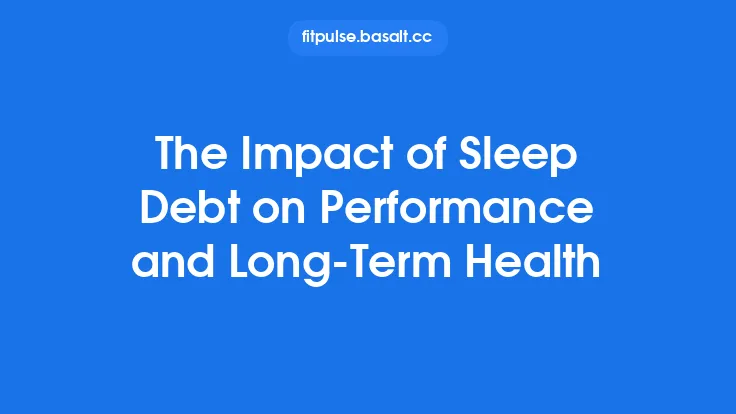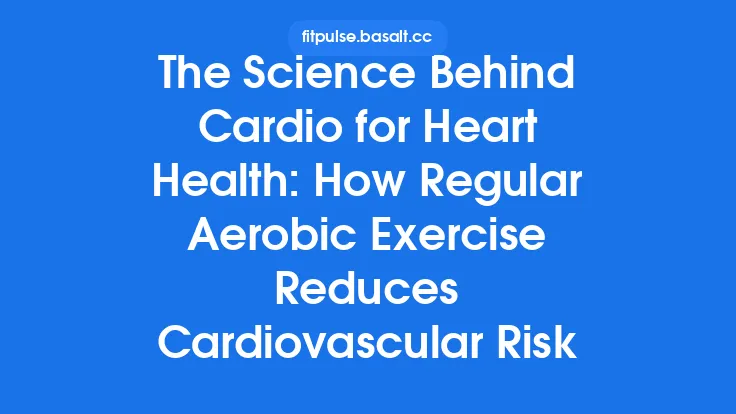Regular physical activity is one of the most potent, non‑pharmacological tools we have for shaping the trajectory of our health across the lifespan. While the day‑to‑day benefits—such as a boost in mood or a quick calorie burn—are often highlighted, the true power of exercise lies in the cumulative, long‑term adaptations that unfold when movement becomes a consistent habit. These adaptations permeate virtually every organ system, influencing how efficiently the body produces energy, how robustly it repairs tissue, and how resilient it remains in the face of physiological stress. Understanding the mechanisms behind these lasting changes not only underscores the value of staying active but also equips health‑promotion professionals with evidence‑based arguments for encouraging lifelong movement.
Physiological Adaptations to Consistent Exercise
When the body is exposed repeatedly to the mechanical and metabolic demands of exercise, a cascade of acute responses triggers chronic remodeling. Key adaptations include:
- Cardiovascular Remodeling – Repeated aerobic bouts stimulate endothelial shear stress, prompting nitric oxide production and vascular smooth‑muscle relaxation. Over months, this leads to increased arterial compliance, a larger stroke volume, and a lower resting heart rate, all of which improve the efficiency of blood delivery without necessarily framing the discussion around disease prevention.
- Respiratory Efficiency – Regular training enhances ventilatory threshold and alveolar‑capillary diffusion capacity, allowing a greater proportion of inhaled oxygen to reach the bloodstream during submaximal effort.
- Neuromuscular Coordination – Motor unit recruitment patterns become more refined, reducing the neural drive required for a given force output. This translates into smoother, more economical movement patterns that persist even when exercise sessions are spaced further apart.
These systemic shifts lay the groundwork for the more specific benefits explored in the sections that follow.
Metabolic Efficiency and Energy Balance
Exercise imposes a recurring demand for ATP, prompting the body to optimize its energy‑production pathways:
- Enhanced Mitochondrial Biogenesis – Endurance training up‑regulates peroxisome proliferator‑activated receptor‑γ coactivator‑1α (PGC‑1α), a master regulator of mitochondrial replication. More mitochondria mean a higher capacity for oxidative phosphorylation, which improves the ability to oxidize fats and carbohydrates at rest and during activity.
- Improved Substrate Utilization – Regular activity shifts the balance toward greater fatty‑acid oxidation during low‑intensity work, sparing glycogen stores and stabilizing blood glucose levels. This metabolic flexibility is a hallmark of a well‑conditioned system and contributes to sustained energy availability throughout the day.
- Resting Metabolic Rate (RMR) Modulation – While the acute thermogenic effect of a single workout is transient, chronic training can modestly elevate RMR through increased lean tissue mass and heightened sympathetic tone, supporting a more favorable energy balance over the long term.
Collectively, these metabolic refinements enable the body to operate more efficiently, reducing the physiological “cost” of everyday tasks and supporting sustained vitality.
Musculoskeletal Strength and Bone Health
The skeletal and muscular systems respond robustly to mechanical loading:
- Muscle Hypertrophy and Strength Gains – Resistance‑type stimuli trigger mechanotransduction pathways (e.g., mTOR signaling) that promote protein synthesis and muscle fiber enlargement, particularly of type II fibers. Over time, this translates into greater maximal force production and improved functional capacity for activities such as lifting, climbing stairs, or carrying groceries.
- Bone Mineral Density (BMD) Enhancement – Weight‑bearing and high‑impact movements generate osteogenic strain, stimulating osteoblast activity via the Wnt/β‑catenin pathway. Consistent loading can increase BMD, especially in the lumbar spine and femoral neck, thereby fortifying the skeleton against age‑related demineralization.
- Joint Integrity and Cartilage Health – Moderate, repetitive joint motion encourages synovial fluid circulation and nutrient diffusion into cartilage, supporting tissue health. Moreover, stronger peri‑articular muscles provide better joint stabilization, reducing the mechanical stress placed on articular surfaces.
These musculoskeletal benefits are pivotal for maintaining independence and reducing the risk of injury as daily demands evolve.
Cardiovascular Capacity and Functional Resilience
Beyond the structural changes in vessels, regular aerobic activity cultivates functional robustness:
- Increased VO₂max – Maximal oxygen uptake rises as a result of both central (cardiac output) and peripheral (muscle oxidative capacity) adaptations. A higher VO₂max expands the “reserve” available for unexpected physical challenges, such as carrying heavy objects or navigating steep terrain.
- Improved Blood Pressure Regulation – Repeated bouts of moderate‑intensity exercise enhance baroreceptor sensitivity, allowing more precise autonomic control of vascular tone. This contributes to steadier blood pressure responses during postural changes and stressors.
- Enhanced Hemorheology – Regular movement reduces blood viscosity and improves erythrocyte deformability, facilitating smoother microcirculatory flow and more efficient oxygen delivery to peripheral tissues.
These cardiovascular improvements underpin a body that can sustain higher workloads with less perceived effort, a cornerstone of long‑term health.
Endocrine Regulation and Hormonal Balance
Physical activity exerts a profound influence on the endocrine milieu:
- Insulin Sensitivity – Muscle contractions stimulate GLUT4 translocation independent of insulin, while chronic training up‑regulates insulin receptor expression. The net effect is a more responsive glucose‑uptake system, which helps maintain stable glycemic control.
- Growth Hormone (GH) and IGF‑1 Dynamics – Exercise, particularly high‑intensity interval protocols, provokes pulsatile GH release, which in turn stimulates hepatic production of insulin‑like growth factor‑1 (IGF‑1). These anabolic hormones support tissue repair, protein synthesis, and lean‑mass preservation.
- Stress‑Hormone Modulation – Repeated exposure to physical stress leads to an adaptive attenuation of the hypothalamic‑pituitary‑adrenal (HPA) axis response. Over time, basal cortisol levels tend to normalize, reducing the catabolic impact of chronic stress on muscle and bone.
A balanced hormonal environment is essential for optimal tissue maintenance, recovery, and overall physiological harmony.
Cellular and Molecular Benefits: Mitochondria, Telomeres, and Epigenetics
The ripple effects of regular activity extend to the cellular level:
- Mitochondrial Quality Control – Exercise stimulates mitophagy, the selective removal of damaged mitochondria, while simultaneously promoting biogenesis. This turnover results in a healthier mitochondrial pool, which is linked to better cellular energy efficiency and reduced oxidative stress.
- Telomere Preservation – Longitudinal studies have shown that individuals who maintain moderate‑to‑vigorous activity levels exhibit slower telomere attrition rates. Telomeres, the protective caps at chromosome ends, are markers of cellular aging; their preservation suggests a deceleration of biological aging processes.
- Epigenetic Modifications – Physical activity can induce DNA methylation changes in genes related to metabolism, inflammation, and muscle function. These epigenetic shifts may enhance gene expression profiles that favor healthful phenotypes, and some evidence suggests that such modifications can be partially transmitted across generations.
These molecular adaptations provide a mechanistic foundation for the observable health benefits that accrue over years of consistent exercise.
Impact on Longevity and Quality of Life
When the aforementioned physiological, metabolic, musculoskeletal, cardiovascular, endocrine, and cellular adaptations accumulate, they collectively shape a trajectory toward extended healthspan:
- Extended Healthspan – By preserving functional capacity, maintaining metabolic flexibility, and protecting cellular integrity, regular exercisers tend to experience fewer periods of disability and a prolonged ability to perform activities of daily living independently.
- Enhanced Physical Function – Improvements in strength, balance, and aerobic capacity translate into smoother execution of everyday tasks, reduced reliance on assistive devices, and a lower incidence of falls.
- Improved Sleep Architecture – Consistent activity promotes deeper slow‑wave sleep and more consolidated sleep cycles, which are critical for tissue repair, memory consolidation, and overall restorative processes.
- Psychosocial Well‑Being – While the article avoids a deep dive into mental‑health mechanisms, it is worth noting that the physical confidence and autonomy derived from sustained fitness often foster a sense of purpose and social engagement, further reinforcing a virtuous health loop.
These outcomes underscore that the benefits of regular physical activity are not merely transient performance gains but enduring enhancements that shape the quality and length of life.
Practical Recommendations for Sustaining Long‑Term Activity
Translating scientific insight into everyday practice requires a strategic, evidence‑based approach:
- Progressive Overload with Periodization – Structure training cycles (macro‑, meso‑, and micro‑cycles) that gradually increase load, volume, or intensity while incorporating deload weeks to allow super‑compensation.
- Varied Modality Integration – Combine aerobic, resistance, flexibility, and proprioceptive training to stimulate multiple physiological systems and prevent monotony.
- Individualized Load Prescription – Use objective markers (e.g., heart‑rate reserve, one‑rep max percentages, perceived exertion scales) to tailor intensity, ensuring sufficient stimulus without excessive strain.
- Consistent Frequency – Aim for a minimum of 150 minutes of moderate‑intensity aerobic work or 75 minutes of vigorous activity per week, complemented by two or more resistance sessions targeting all major muscle groups.
- Recovery Optimization – Prioritize sleep hygiene, adequate protein intake (≈1.6 g·kg⁻¹·day⁻¹ for active adults), and active recovery modalities (light mobility work, low‑intensity cycling) to support tissue repair.
- Monitoring and Feedback – Employ wearable technology or periodic fitness assessments (VO₂max tests, strength benchmarks, body composition analysis) to track adaptations and adjust programming accordingly.
- Lifestyle Integration – Embed movement into routine tasks—standing desks, active commuting, or brief “exercise snacks” throughout the day—to reinforce the habit loop and reduce sedentary periods.
By adhering to these principles, individuals can harness the full spectrum of long‑term benefits that regular physical activity offers, ensuring that health improvements are not fleeting but become a permanent feature of their physiological landscape.
In sum, the cumulative impact of sustained exercise reverberates through every level of biological organization—from cellular mitochondria to whole‑body functional capacity—crafting a resilient, efficient, and vibrant organism capable of thriving across the decades. The evidence is clear: making physical activity a lifelong habit is one of the most powerful investments we can make in our overall health.





